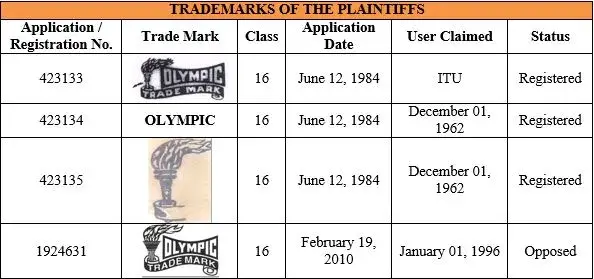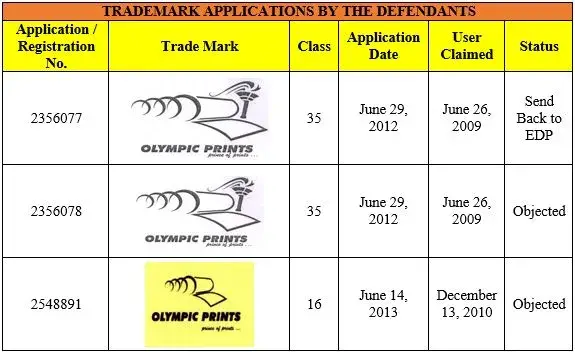The High Court of Madras, on September 11, 2015, granted an interim injunction in favour of Mr. Noor Mohamed, proprietor, Olympia Paper & Stationary Stores and Olympic Cards Ltd. represented by its Managing Director, Mr. Noor Mohamed (the Plaintiffs) and against Olympic Prints, Olympic Traders and Olympic Xerox (the Defendants) in respect of the trademarks OLYMPIC (label), OLYMPIC (word mark) and DEVICE OF A TORCH in Noor Mohamed & Ors. v. Olympic Prints & Ors. (CS(OS) 299/2014).
Brief facts of the case
- The Plaintiff No. 1 is stated to be carrying on business as the sole proprietor under the name and style of Olympia Paper & Stationary Stores. The Plaintiff No. 2, Olympic Cards Ltd., is a public limited company and licensee of the Plaintiff No. 1, who is the chairman and Managing Director of the Plaintiff No. 2.
- The Plaintiffs are engaged in the manufacture and marketing of various stationary products including wedding cards, visiting cards, invitation cards, greeting cards, inland letters, envelopes, paper and paper articles, cardboard and cardboard articles, books, diaries etc.
- The father of the Plaintiff No. 1 is stated to have adopted and used the aforesaid trademarks in 1962, and his proprietary concern was subsequently taken over as a partnership firm by his two sons including the Plaintiff No. 1. After the death of the other son, the partnership firm was dissolved and in 2005, the Plaintiff No. 1 became the sole proprietor of the concern under the name and style of OLYMPIA PAPER AND STATIONARY STORES.
- The Plaintiff No. 1 has obtained statutory protection by registering the said marks under the Trade Marks Act, 1999, which are valid till 2025.

- The Plaintiffs are stated to have become aware of the Defendant No. 1’s operation under the name OLYMPIC PRINTS and using identical trademarks as the Plaintiffs in respect of digital and print media, through advertisements made in the magazine named ‘Print Week’ in the issue dated March 10, 2014. The Plaintiffs carried out a search in respect of the trademark OLYMPIC and came across a website of the Defendant No. 1 calling themselves to be a part of the OLYMPIC GROUPS wherein the DEVICE OF THE TORCH as registered by the Plaintiffs has been used by the Defendant No. 1 and its group which amounts to infringement of the Plaintiffs’ marks.
- The Plaintiffs came to know that the Defendants have only applied for the registration of the mark OLYMPIC PRINTS in classes 16 and 35 in 2012 and 2013 respectively.

Contentions of the Plaintiff
- The essential feature of the Plaintiffs’ mark OLYMPIC DEVICE is the word OLYMPIC with a device of a torch in the said label. The Defendants have infringed the registered trade mark OLYMPIC of the Plaintiffs as well as the registered DEVICE OF THE TORCH.
- The Plaintiffs are the prior user of the said marks since 1962 and the Defendants have filed the above applications only in 2012 and 2013 respectively claiming user rights also only from 2009 and 2010 respectively.
- The Plaintiffs intend to oppose the registration of the above mark once it is advertised in the Trade Marks Journal.
- The Defendant No. 1 has dishonestly and fraudulently adopted the impugned mark OLYMPIC PRINTS knowingly and being fully aware of the Plaintiffs’ existence.
- The Plaintiffs claim that there has been a steadily increasing demand for the product of the Plaintiffs in the domestic market and the sales turnover of the goods under the said trademarks for the year 2013-2014 are stated to be INR 523,860,612/-.
- The Plaintiffs have acquired the status of a well-known trademark under the provisions of the Trade Marks Act, 1999 and the Defendants’ mark OLYMPIC PRINTS is identical to the well-known and registered trade mark of the Plaintiffs.
Contentions of the Defendants
- The Defendants contended that the trademark OLYMPIC PRINTS was bonafidely conceived and adopted by the Defendant No. 1 in the year 2010.
- The mark OLYMPIC PRINTS is represented in a distinctive lettering style and artwork capable of distinguishing the services rendered by the Defendant No. 1. The Defendants’ trademark has no reference whatsoever to the kind, quality or the intended purpose of services and does not consist of marks or indication in the trade which is capable of distinguishing the services of the Defendant No. 1 from those of others.
- The Defendants are engaged in making plates for the printing shops, and produce and supply around 20,000 to 25,000 printed tags per day for textile customers. The mark OLYMPIC PRINTS of the Defendants has become very popular.
- The Plaintiffs, except for making a bald allegation against the bonafide adoption of the said marks by the Defendants, have not substantiated the same with any documentary proof. Further, the Plaintiffs’ very claim of adoption as early as in the year 1962 is false.
- Both the marks are not visually, phonetically and structurally or deceptively similar. There are several added features in the Defendants’ mark and there is no chance of deception and confusion in the minds of the trade and public. The Plaintiffs have not made out a prima facie case or established balance of convenience in their favour.
- The goods which are manufactured by the Defendants are different and not one and the same as that of the Plaintiffs. The goods manufactured by the Defendants are not for selling to the common man, on the other hand, it is meant for selling to the class of customers, namely, Printers. Therefore, there is no possibility for any confusion in the minds of the public. The Plaintiffs have knowledge from 2009 about the usage of the trademark by these Defendants therefore the case is hit by delay and laches. The Defendants are not doing business in Chennai.
- The mark OLYMPIC cannot be claimed exclusively by the Plaintiffs.
Order of the Court and its Implications
The Hon’ble Court held that the Plaintiffs have made out a prima facie case for grant of interim relief as sought for in the interim applications. For this purpose, the Court observed that it is to be seen in the present case under the above stated facts and circumstances as to whether the Plaintiffs have come before this Court immediately on knowing the infringement of their trademark and the impugned passing off action by the Defendants. In this regard, the Hon’ble Court considered the Plaintiffs’ contention that they became aware of the infringement by the Defendants only on March 10, 2014, and this contention was not specifically denied by the Defendants and on the other hand, except making a vague statement as though the Plaintiffs were aware of the trademarks of the Defendants from 2009, the Defendants have not filed any material proof in support of such contention.
The Hon’ble Court further held that the word OLYMPIC is a registered trademark of the Plaintiffs therefore, cannot be used by any other person and if there is any such use, certainly, it would amount to infringement of the said registered word mark.
The Court held that the Plaintiffs have established a strong prima facie case in their favour by showing that they are in the trade using the trade mark for more than 50 years and are doing good business running to several crores every year. The court further held that if no injunction is granted, it would certainly cause irreparable injury to the Plaintiffs as their registered trademarks are being used by the Defendants which would be construed as though the Defendants’ trademark is that of the Plaintiffs’.
Concluding Remarks
The aforesaid ruling calls for a debate whether exclusive trademarks rights over Olympic marks such as OLYMPIC, DEVICE OF TORCH etc. can be granted to traders in India.
Interestingly, Olympic trademarks enjoy a privileged status as they are protected by a statute over and above ordinary trademark protection. According to Rule 7 of the Olympic Charter, the International Olympic Committee (IOC) is granted ownership of the Olympic rings as well as the Olympic flag, motto, anthem, identifiers, designations, emblems, the Olympic flame and torches (the “Olympic properties”). All rights to any and all of the Olympic properties belong exclusively to the IOC, including rights to their use such as in relation to profit-making, commercial or advertising purposes.
It is further interesting to note that many countries have adopted permanent national legislation for protecting the Olympic properties, such as China’s legislation titled “Regulations on the Protection of Olympic Symbols of the People’s Republic of China” and the United States of America’s legislation titled the “Olympic and Amateur Sports Act” giving special protection to Olympic marks. The Olympic and Amateur Sports Act basically says that without the consent of the United States Olympic Committee (USOC) or IOC, any person who uses, for the purpose of trade to induce the sale of any goods or services or promote any theatrical exhibition, athletic performance or competition, using either the symbol of the IOC (which is the 5 interlocking rings) or any trademark, trade name, etc. that represents association with or authorization by the IOC or the USOC is subject to a civil suit.
Some countries are also signatories to the Nairobi Treaty on the Protection of the Olympic Symbol (1981) which is administered by the World Intellectual Property Organization (WIPO) and is open to any state that is a member of that organization, the United Nations or any of its specialized agencies, or the Paris Convention. According to WIPO, 51 countries are contracting members. States that have signed the Treaty are obliged to refuse or invalidate the registration as a mark and to prohibit the use for commercial purposes of any sign consisting of or containing the mark, except with the IOC’s authorization. India signed the Nairobi Treaty on June 30, 1983 and ratified the same on September 19, 1983.
Pertinently, Item 21 of the Schedule of The Emblems and Names (Prevention of Improper Use) Act, 1950 in India, as amended on August 18, 1978, prohibits the use of the name and emblem of the International Olympic Committee consisting of five inter-laced rings for professional and commercial purposes such as in a trademark.
The aforesaid Order dated September 11, 2015 can be accessed here.

